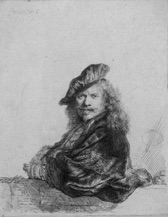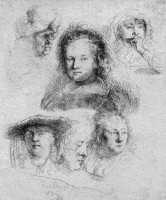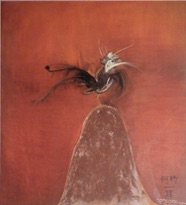



Self-Portrait Leaning on a Stone Sill – Rembrandt
This etching was purchased from the National Gallery of Australia and is a re-strike etching from Rembrandt's original plate - it retains the visible indentation of the plate just outside the image and is clearly the work of his master hand. This magnificent self-portrait represents the high art of self-promotion. It serves as an engaging calling card in which Rembrandt stakes his claim to artistic excellence and shares his sense of well being at this moment in his thriving career. Rembrandt's extraordinary talent and skill in making printed art was actually the main source of his international fame during his lifetime. Unlike oil paintings, paper etchings were light, relatively cheap and they travelled easily, so they quickly became sought after by art collectors at home and abroad.
Overall 535 x 555
Studies of Heads of Saskia and Others – Rembrandt
This splendid Rembrandt engraving from 1636 depicts six subjects, with the only subject identified by name, Saskia his wife, the most prominent in the upper centre. Her high-necked dress is represented through the use of delicate cross-hatched lines. Her wispy curls gently fall to her side, and she appears as if wearing a veil or sheer headdress, gazing calmly out at the viewer. The two figures above her also have headdresses and the three figures beneath Saskia seamlessly merge together. Each subject gazes off in a different direction, encouraging the viewer's eyes to jump across the page, as if trying to discern what each subject is gazing at. This was purchased from the National Gallery of Australia and is a re-strike etching from Rembrandt's plate. He was one of the first great painters to explore etching and is considered the peerless master of this artform.
Overall 535 x 555
72
The Ruins of Palmyra, Syria - rare panoramic 1736 engraving
Afbeelding van de Puinhoopen van Palmyra, Anders Tadmor, Aan de zuidzyde genomen. This is an almost 300-year-old original copper engraving of the ruins of Palmyra, Syria. This rare, large engraving was printed in 1736 and was, because of its size, printed in multiple parts which were connected before insertion in a book. An engraving of this size is especially rare because it was difficult to make large paper and to print from plates with such large sheets. There is significant historical value in this picture because it shows Palmyra at a time when it was one of the best preseved sites from antiquity. Sadly many significant structures in this picture were destroyed by ISIS in 2015 because it was considered idolatrous, so this is a precious record of Palmyra, one of the most important cultural centres in the ancient world.
Overall 1130 x 555
Previous Page
121
62
61
"Lyre Bird" – Brett Whiteley – large framed art print
Decorative print of Brett Whiteley's Lyre Bird in a handsome large gold frame. At the bottom of the frame Whiteley has written in the corner “a pointless painting needs looking at for a long time in order to think (about it)”. Indeed, it is only after close examination that you can discern the many birds that have been incorporated into the image around the lyre bird's head. Can you find eleven of them?
Overall 990 x 1190
Next Page